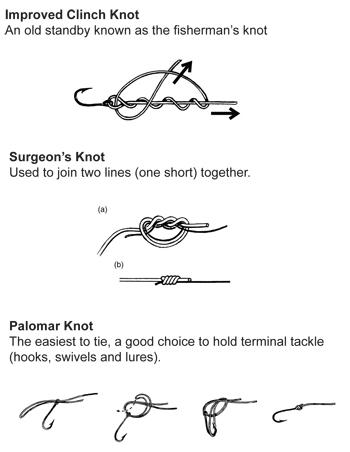
Tying better knots
More fish are probably lost because of improperly tied knots than any other single reason. Yet anglers who spend hours practicing their casting or making lures often neglect this simple fundamental. But if tying better knots might help us land more fish, it makes sense to give knot tying a little more attention.

Learn to tie a few simple knots well
There are dozens of knots for the angler. They publish whole books with nothing but pictures of how to tie knots. But start with just three knots, and learn how to tie them really well. Some good choices are:
- Improved clinch knot – to tied the hook to the line
- Surgeons knot– to tie two lines together
- Palomar knot – another knot to tie the hook to the line
Make sure you know how to tighten every knot properly
Knots break when they slip, and they slip if they aren’t properly tightened. Pull on all the lines going into or coming out of the knot. Tighten both the short tag ends and the longer standing lines.
Just before you tighten the knot, moisten it with saliva
This little bit of moisture does two things: it helps the knot “seat" or fully tighten, and it also reduces friction heat that can cause the leader or tippet to stretch and weaken.
Test each knot before you make that first cast
Give the line a few healthy tugs. Wrap the bend of the hook around a ring (the finger holes of your hemostat, a d-ring on your vest, etc.) and tug on the tippet to make sure the knot is secure.
Practice tying knots
Most people either laugh or groan at the thought of practicing knots. But standing on the shore with fish jumping all around you is a terrible place to try to remember how to tie a clinch knot. It’s not like you have to practice every day – you’re not learning a musical instrument. But grab a bit of line and some hooks, and tie a few favorite knots over and over again. Do this a couple of times and you’ll be pleased with how easily it comes back to you when you’re on the water.
Three knots to know
Also visit:
- Animated Knots -- a favorite web site for know tying instructions


